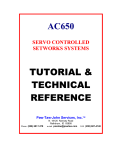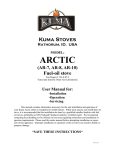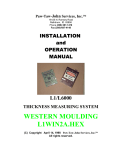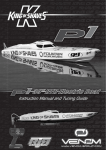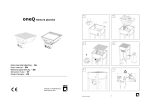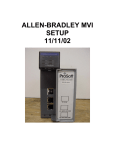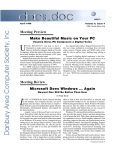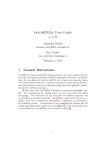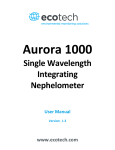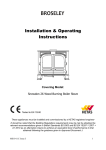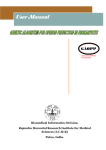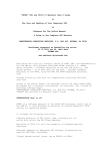Download AC651 Manual - Paw-Taw
Transcript
INSTALLATION and OPERATION MANUAL AC651 SERVO CONTROL MODULE Revised 9-4-98 Printed 11-19-98 PAW-TAW-JOHN SERVICES, INC.™ 18125 N RAMSEY ROAD RATHDRUM ID 83858 (208)687-1478 FAX(208)687-4148 (888)687-1478 E-MAIL [email protected] (C) Copyright 1998 Paw-Taw-John Services, Inc.™ All rights reserved. Paw-Taw-John Systems, Inc. AC651 SERVO CONTROL MODULE INTRODUCTION ABOUT Paw-Taw-John Services, Inc. ABOUT SERVO CONTROL SYSTEMS Paw-Taw-John Services, Inc. SERVO CONTROLLERS TYPICAL SYSTEM COMPONENTS FIRMWARE FEATURES SOFTWARE FEATURES POWER SPECIFICATIONS OPERATING TEMPERATURE CONFIGURATION OPTIONS SYSTEM INSTALLATION SERVO SYSTEM COMPONENTS MECHANICAL INSTALLATION ELECTRICAL INSTALLATION AC651MB RACK DATA INPUTS/OUTPUTS 1 1 2 4 6 7 7 7 8 1 2 3 4 AC651 INITIAL SERVO SYSTEM SETUP AC651 CARD RACK CONFIGURATION MULTIPLE CARD RACK CONFIGURATION AC651 CARD ADDRESS SETUP AC651 CARD SERVO OUTPUT SETUP VOLTAGE TESTS AND WIRING CHECKS TRANSTERM 5 SETUP TRANSTERM 5 TERMINAL OPERATION DEFINITION OF SYSTEM PARAMETERS COORDINATE SYSTEM SYSTEM RESPONSE MISCELLANEOUS PARAMETERS ENTERING SYSTEM PARAMETERS TRANSTERM DISPLAY MESSAGES SERVO LOOP DYNAMICS SETUP OFFSET CALIBRATION PROCEDURE AC651 FACE PLATE INDICATIONS 1 2 2 3 4 5 7 9 9 11 12 13 15 1 3 5 PLC INTERFACING TO AC651MB RACK AC651MB RACK DATA INPUTS/OUTPUTS PROGRAM DATA SPECIFICS PLC DATA INPUT TIMING 1 3 7 TROUBLESHOOTING INITIAL SYSTEM TROUBLESHOOTING OPERATIONAL SYSTEM TROUBLESHOOTING TransTerm (TT5 KEYPAD) TROUBLESHOOTING 1 2 3 PROGRAM IC REMOVAL AND INSTALLATION IC REMOVAL PROCEDURE INSTALLATION 1 1 INTRODUCTION ABOUT Paw-Taw-John Services, Inc.™ Paw-Taw-John Services, Inc.™ is a designer and manufacturer of semicustom servo controller systems and associated components used in wood products and other manufacturing industries. The company brings together individuals with decades of experience in systems and software design, custom electrical and electronic systems manufacturing, and technical sales with expertise in sawmill operation and automation. Paw-Taw-John Services, Inc.™ specializes in systems that provide greater user flexibility, lower maintenance, increased productivity, quicker pay-back, and higher yield. Our systems are in use worldwide by companies wanting more intelligence with their controllers. Paw-Taw-John Services, Inc.™ systems are easier to setup, modify, and use in everyday operation than most programmable controllers. No special programming language must be learned and all programming may be done from a keypad terminal or 486 computer terminal. Our systems also interface with most popular position and limit sensors directly or via economical interfaces boxes we can supply with systems. Paw-Taw-John Services, Inc.™ can also control most all popular servo and proportional valves directly. This offers a significant reduction in equipment suppliers required to construct your servo system. ABOUT SERVO CONTROLLERS A servo control system, when applied to positioning, is an electromechanical system that knows where it is at all times and provides for external data input, whether from sensors, computers, or humans, to act upon or produce a response to the input. Most often in industrial applications the servo system is used to control a linear motion such as positioning of a saw or movement of knees on carriage. Each isolated linear motion is referred to as an axis. Paw-Taw-John Services, Inc.™ systems are used to control one or more axes. Several of the axes may be interactive in multi-axis systems such as moving multiple saws simultaneously while still permitting individual saw adjustment. Copyright 1998 Paw-Taw-John Services, Inc.™ INTRODUCTION 1 A typical servo control system might consist of a hydraulic cylinder used to move a saw. The hydraulic fluid power is directed by a servo valve under the control of the servo controller. Some type of position sensor attached to the saw would provide positional data to the controller. To make the system usable an operator console might permit the selection of several cut lengths. In a real-time example the operator could choose a 10” cut width by pressing the 10” button on the console. This requests the servo controller via a PLC to move the saw to the 10” position. The controller sends a signal to the servo valve to move the hydraulic cylinder in the correct direction. Information returned to the controller from the saw position sensor is compared with the operator requested position and movement of the cylinder continues until the saw position reaches 10”. At that position the controller removes the signal from the servo valve and the saw stops. Paw-Taw-John Services, Inc.™ SERVO CONTROL SYSTEMS Paw-Taw-John Services, Inc.™ servo controllers are semi-custom systems designed and assembled from a group of standard components. The heart of the system is an AC651 servo control module. The AC651 is designed to accept positional information from many industry standard sensors. It will output the appropriate control for most industry standard servo valves. Sixteen inputs and a data strobe are provided for receiving positioning information from a PLC. Copyright 1998 Paw-Taw-John Services, Inc.™ INTRODUCTION 2 The specific operating characteristics and personality of the AC651 are a function of the firmware programming that directs the microcontroller contained within. This program is created special to meet each PLC system’s specific operating requirements. The AC651 servo controller high speed serial communications port may be connected to a terminal or computer via a telephone style modular jack for system setups and calibration, data tracking, and certain operating program modifications. Presently the Computerwise TransTerm 5 terminal and 486DX computers are used. This feature makes possible on-site setup changes or accommodates for mechanical component wear or replacements. One final serial communications port allows several AC651s to intercommunicate making possible multiple controller systems that can work in harmony. In this manner one command BYTE from a PLC control might permit separate and different actions from two or more controllers simultaneously. The AC651 has 16 inputs and 1 output that can operate between 5vdc to 30vdc. A 4-position dip switch, located on the component side of the circuit board, provides the addressing necessary in multiple card configurations and for special functions. The AC651 operates from a Firmware program stored in a 28-pin memory IC. The card has another memory device for storing set and servo dynamics parameters, stroke limits, and transducer interfacing information. Both of these devices are non-volatile so there data is not lost if power is removed. The main I/O connector opposite of the face of the card is a Euro-style 32 pin dual readout. This provides the card with flexibility to mount in single or multiple cardrack configurations. A complete custom Paw-Taw-John Services, Inc.™ servo control system is built from one or more AC651 controllers. Servo systems also typically include power supplies, wire and cable terminating blocks, suitable enclosures, PLC’s and custom operator panels. TYPICAL SYSTEM COMPONENTS Copyright 1998 Paw-Taw-John Services, Inc.™ INTRODUCTION 3 A typical servo system from Paw-Taw-John Services, Inc.™ will be constructed from one or more of the components below: 1. System Control Enclosure: The servo control enclosure contains a cardrack used for support and interconnection to one or more AC651 Servo Controller Cards, power supplies necessary to operate the controller cards and other system components, AC power switch and fuses, and suitable terminal blocks for connecting external component wiring. All of these parts are housed in an NEMA 12 enclosure designed for wall mount. Care is taken in design to provide wire ducting so that primary AC and secondary DC may be kept separated. The enclosure should be drilled for attachment of conduits during installation. 2. Temposonic Probe: A linear transducer mounted inside the center of each cylinder used to measure position. A magnet that moves with the piston reflects an internal square wave generated at the probe head. The reflected wave is processed and provides accuracy to 0.001 inches. 3. Recirculation Box: The Recirculation box contains a circuit card (AC700) that distributes the servo drive and Temposonics’ signals for a single axis. A system may have one or more Recirculation boxes. The card controls the number of “recirculations” that the position signal will make in the Temposonic probe. The more recirculations the greater the resolution. The AC700 also sets the probe operating frequency and triggering signal. Please refer to Recirculation box manuals for setup and operation information. 4. Operator Control Panel: The Operator Control Panel is the main user system operating and control interface. This panel is typically custom designed and constructed to suit the requirements of the servo system. An assortment of Set control lighted push-button switches and other switches or joysticks for jog and cut control allow the operator to control the system. This panel is connected to the System Control Enclosure via a multiconductor cable. Copyright 1998 Paw-Taw-John Services, Inc.™ INTRODUCTION 4 5. TransTerm 5 Terminal: The keypad terminal is used to display system status and adjust operating parameters, axis offsets, jog functions, and for troubleshooting. Refer to system to the System Operation section of this manual for specific operating details. The TransTerm 5 terminal connects directly to the AC650 cards inside the System Control Enclosure. 6. Servo/Proportional Valves: Servo Valves, and in some systems proportional valves, control the flow of hydraulic pressure to the hydraulic cylinders. One valve will be associated with each axis. The Servo Valves are controlled from the servo output of AC651 cards located in the System Control Enclosure. Refer to the system installation section of this manual for adjustments to the AC651 that may be required by any specific valve type. 7. 486DX computer: These computers are interfaced to the AC651 cards via a highspeed dual channel interface card (PC1) mounted inside the 486DX computer and communications cable. This system interface is used for more complicated system controls. All setup and operational characteristics are controlled from the computer. 8. PLC’s: These machine controllers are interfaced to the AC651 cards via a 16 point DC output module connected to a 16 point terminal strip located on the AC651MB card rack. A data strobe is also required from the PLC to strobe data into the AC651 cards. AC651 SERVO CONTROLLER CARD FEATURES AND Copyright 1998 Paw-Taw-John Services, Inc.™ INTRODUCTION 5 ELECTRICAL SPECIFICATIONS The AC651 servo control card is used for linear positioning and hydraulic servo valve control. It is used with PLC’s as a external servo controller. A PLC can control 1-8 axes per bank. FIRMWARE FEATURES: • Isolated 17 inputs (5-32VDC) • Non-volatile memory storage so no battery backup is required. • High-speed RS485/RS422 SDLC serial port. Baud rates of 1.2 m standard • Low-speed RS-422 serial port accessible through a 6 pin phone jack. Baud rates of 2400 to 19.2k. • Digital interface to MTS(R) Temposonics(R) linear transducers. • Provides +/- 0-100 mA current output for Servo valves. • Has +/- 10vdc output capability. • Dip switch auto-null selection. • Addressable Dip switch settings for up to 8 axes per bank. • Red status LED’s mounted on the face of the board. • Uses Euro-style connector for easy installation in single or multiple card racks. • Can be interfaced to RS-232 serial communication port through inexpensive converter. Copyright 1998 Paw-Taw-John Services, Inc.™ INTRODUCTION 6 SOFTWARE FEATURES • Custom programs embedded on UV EPROM. • Programs written to interface card control through a phone jack to dummy computer terminals. • Programs written to interface card to PC’s through high-speed serial port. • Personal Computer (PC) High-speed communications board (PC1) available. • Data presented in thousandths of inches or centimeters. • Programs written for special applications. POWER SPECIFICATIONS • +5vdc @ .5 amps • +15vdc @ .1 amps* • -15vdc @ .1 amps *When using TransTerm 5 Computer terminal, +15vdc .5 amps is required. OPERATING TEMPERATURE -40 TO 150 deg. F ( -40 to 66 deg. C.) CONFIGURATION OPTIONS 1. 486DX computer to AC651MB card rack. Copyright 1998 Paw-Taw-John Services, Inc.™ INTRODUCTION 7 486DX computer AC651MB cardrack Communications cable 2. 486DX computer to multiple card rack system 3. Transterm 5 handheld terminal to single card rack Copyright 1998 Paw-Taw-John Services, Inc.™ INTRODUCTION 8 4. PLC with TTL input/out modules interfacing to AC651MB rack. PLC CONTROLLER For further information, please contact Paw-Taw-John Services, Inc.™ at 208-687-1478. Copyright 1998 Paw-Taw-John Services, Inc.™ INTRODUCTION 9 CONFIGURATION OPTIONS 1. 486DX computer to AC650MB card rack. 486DX computer AC650MB cardrack Communications cable 2. 486DX computer to multiple card rack system 3. Transterm 5 handheld terminal to single card rack AC651 SERVO CONTROLLER CARD The AC651 servo control card is used for linear positioning and hydraulic servo valve control. It is used with PLC's as an external servo controller. A PLC can control 1-8 axes per bank. FIRMWARE FEATURES: •Isolated 17 inputs (5-32VDC) •Non-volatile memory storage so no battery backup is required. •High-speed RS485/RS422 SDLC serial port. Baud rates of 1.2 m standard •Low-speed RS-422 serial port accessible through a 6 pin phone jack. Baud rates of 2400 to 19.2k. •Digital interface to MTS® Temposonics® linear transducers. •Provides +/- 0-100 mA current output for Servo valves. •Has +/- 10vdc output capability. •Dip switch auto-null selection. •Addressable Dip switch settings for up to 8 axes per bank. •Red status LED's mounted on the face of the board. •Uses Euro-style connector for easy installation in single or multiple card racks. •Can be interfaced to RS-232 serial communication port through inexpensive converter. SOFTWARE FEATURES: •Custom programs embedded on UV EPROM. •Programs written to interface card control through a phone jack to dummy computer terminals. •Programs written to interface card to PC's through high-speed serial port. •Personal Computer (PC) High-speed communications board (PC1) available. •Data presented in thousandths of inches or centimeters. •Programs written for special applications. POWER SPECIFICATIONS: •+5vdc @ .5 amps •+15vdc @ .1 amps* •-15vdc @ .1 amps *When using TransTerm 5 Computer terminal, +15vdc .5 amps is required. OPERATING TEMPERATURE: -40 TO 150 deg. F ( -40 to 66 deg. C.) AC651 MOTHERBOARD The AC651 Motherboard provides housing for up to four AC651 servo controller cards, as well as providing hookup location for power, inputs, outputs, serial communications terminals, servo and MTS® Temposonics®. Multiple card racks can be attained through the serial communications terminal. AC651 INITIAL SERVO SYSTEM SETUP HARDWARE CHECKOUT WARNING INSURE ALL LOCAL LOCKOUT PROCEDURES ARE FOLLOWED!!! AC651 CARD RACK CONFIGURATION M A S T E R S L A V E Refer to figure above for the following check. 1. Ensure 4 Master jumpers wires are installed near card 1 connector. 2. Install if not present. NOTE: In multiple card rack configurations, the second rack has 4 jumpers installed in the Slave locations. MULTIPLE AC651 CARD RACK CONFIGURATION Refer to drawing below. 1998 Paw-Taw-John Services, Inc. ™ INITIAL SYSTEM SETUP 1 1. Install jumper cable between GSC 2 of rack 1 and GSC 1 of rack 2 using the following cabling diagram. COMMUNICATIONS CABLE INTERCONNECT RACK 1 GSC2 RACK 2 "-REC RED "-REC "+REC BLK "+REC "COM WHT/BLK PAIR "COM "+XMT GRN "+XMT "-XMT BLK "-XMT GSC1 SHIELD ARE CONNECTED TO EARTH GROUND NOTE: Usually, a three pair shielded cable is used for this jumper. AC651 CARD ADDRESS SETUP 1. Referring to the AC651 drawing and the DIP Switch Table below, adjust the card address DIP switch positions on each AC651 card. Dip Switch Area 1998 Paw-Taw-John Services, Inc. ™ INITIAL SYSTEM SETUP 2 AC651 DIP SWITCH POSITIONS AXIS 1 2 3 4 5 6 7 8 Switch 1 OFF ON OFF ON OFF ON OFF ON Switch 2 OFF OFF ON ON OFF OFF ON ON Switch 3 OFF OFF OFF OFF ON ON ON ON Program Bit Codes 1 2 3 4 5 6 7 8 Example, for single axis systems, address switches 1, 2, and 3 are off. NOTE: Axis 1 is always the MASTER. 2. DIP position number 4 is the auto-null enable. When on, the AC651 card supplies correct servo drive current to counter any out of null conditions the valve might have. In this mode the target position and the actual position on the terminal should be within 0.001”. AC651 CARD SERVO OUTPUT SETUP 1. The AC651 servo drive output range may require adjustment depending on the type of servo valve being used. Refer to the servo valve manufacture’s specifications to determine the amount of servo drive current required. 2. The AC651 is shipped from Paw-Taw-John Services, Inc. ™ factory preset to 30mA. A 50K-ohm resistor is installed in position R18. 3. Care should be taken if the value of R18 must be changed. A qualified electronic technician should be used to perform the change or the AC651 card(s) may be returned to Paw-Taw-John Services, Inc. ™ 4. Refer to the drawing and table below should it be necessary to change servo output current. (Note: Each AC651 card must be matched to it’s own servo valve.) 1998 Paw-Taw-John Services, Inc. ™ INITIAL SYSTEM SETUP 3 AC651 SERVO OUTPUTS Current Adjustment Servo Valve Current Required 25 mA 30 mA 50 mA 60 mA 100 mA 5. R18 Resistor Value 39K-ohm 50K-ohm 82K-ohm 100K-ohm 180K-ohm Install all AC651 cards in their correct positions with the Master in the left most position. (Note: the card connectors are keyed to prevent incorrect orientation.) VOLTAGE TESTS AND WIRING CHECKS Refer to figure above for the tests and checks that follow. 1. Remove all AC651 cards from cardrack before applying power. 1998 Paw-Taw-John Services, Inc. ™ INITIAL SYSTEM SETUP 4 2. Apply AC power to system and verify correct DC voltages are present at power terminals on the AC651 cardrack per table below. AC651 CARDRACK VOLTAGES Terminals From +5VDC +15VDC -15VDC +24VDC* 3. 4. 5. 6. Voltage To Minimum Maximum GND +4.9VDC +5.2VDC GND +14.9VDC +15.2VDC GND -14.9VDC -15.2VDC 24V RET* +5VDC +30VDC * Input/Output Supply Voltage Turn off AC power. Verify MTS Temposonics transducer connections are correct per drawing. Verify SERVO+ and SERVO- lines are present at the correct terminals per drawing. Verify that 150 ohm resistors are installed Between the REC+, RECand XMT+, XMT- terminal pairs of the GSC 1 and GSC 2 terminal blocks. TRANSTERM 5 (TT5 Keyboard) SETUP 1. Install the keypad cable between TransTerm 5 and KEYPAD jack on face of the left most AC651 card (master position). 2. When power is applied the TransTerm 5 should beep three times. The top line will display the AC651 firmware program name, date and whether the AC651 card is a master or slave. The bottom line will initialize for a moment and then display a card status message. PRGMNAME 1/15/95 MASTER SYSTEM OK 3. A TransTerm 5 register check should be conducted next to make sure the TT5 is set to properly communicate with AC651 cards. It is nec- 1998 Paw-Taw-John Services, Inc. ™ INITIAL SYSTEM SETUP 5 essary to switch to the setup mode by entering the following keystrokes: S2 (blue key), S1 (red key), and S2 (blue key). 4. The top line shows SR indicating the setup register mode and two sequential counts from 1 to 8 to mark data bit positions. 5. The bottom line of the display shows which of the four registers (SR1 - SR4) is active, the data for that register, and the blinking cursor at the first new data entry position. Each register contains 8 data bits that are either “1” or “0”. This data determines how the TT5 will work. It is necessary to have the registers filled with the exact sequence of “1”s and “0”s so the terminal can talk with the AC651. 6. The bit sequence for register SR1 should be as follows: SR1=00000000 If the data displayed does not match, key in “00000000”. Then press the ENTER key. If the data displayed does match the bit sequence, just press the ENTER key to accept the data as displayed. 8. After the ENTER key is pressed in step 7, the display will automatically increment to the next register. Repeat the procedure in step seven for all four registers confirming or changing the data bits to match the following: 1998 Paw-Taw-John Services, Inc. ™ INITIAL SYSTEM SETUP 6 SR2=00000010 SR3=00001001 SR4=00000000 9. Hit the ENTER key after each register entry. When all four registers are correct press the CLEAR key to exit the setup mode. Please refer to TransTerm 5 Troubleshooting if no data is displayed Also refer to the TransTerm 5 User’s Manual (included with the system) for more detail on terminal setup. Starting system parameters are loaded by Paw-Taw-John Services, Inc. ™ at time of manufacture. TRANSTERM 5 TERMINAL OPERATION The TransTerm 5 is a complete dummy terminal capable of all functions used on standard personal computer systems. The TT5 may be powered using an external 12VDC power unit or powered via it’s data cable from the AC651. Typically AC651 cards provide 12 to 15 volts through their 6-pin keypad jacks. The TT5 terminal has two shift buttons labeled S1 and S2. S1 is Red and when first depressed activates all red characters on the keypad. An example would be if a function requires “I” to be entered; first press S1 which activates the Red characters, then press the I key to send the command. The S2 key activates the all Blue characters on the keyboard. To enter a “P” requires first pressing the S2 key to activate Blue characters and then the P key to send the command. An example is shown below. It is a good practice to press the CLEAR key before beginning a command sequence to assure the TransTerm 5 is not already in the middle of a com 1998 Paw-Taw-John Services, Inc. ™ INITIAL SYSTEM SETUP 7 mand sequence. Single character or word commands in Black on the keyboard are direct entry commands in that they may be entered at anytime after the CLEAR key has been pressed. Refer to the table below for valid AC651 commands entered from the TT5 terminal. AC651 COMMANDS Command Sequence CLEAR ENTER SPACE DELETE S1 Î I S2 Î 4 S2 Î P 1 2 S1>2 Function or Action Return system to Run mode Enter values previously typed in Scroll forward to next entry Scroll backward to previous entry Data transfer information screen Enter Servo jog enables Enter Parameter Table Displays Axis "1" Target and Actual Position Displays Axis "2" Target and Actual Position Servo status data screen Shortly after power-up of the system, the TransTerm 5 will display the following: PLC51D1 04-23-93 SYSTEM OK At any time the TT5 terminal may be placed in or returned to the RUN MODE by depressing the CLEAR key. Refer to the above display. DEFINITION OF SYSTEM PARAMETERS 1998 Paw-Taw-John Services, Inc. ™ INITIAL SYSTEM SETUP 8 COORDINATE SYSTEM 1. The AC651 servo control system measures movement of the cylinder in inches. The coordinate system can be set up to place the zero reference at any point that is most useful. The direction of “Increasing Position” can also be selected. 2. The EXT. TO ZERO IF 1 operating parameter establishes the direction of increasing cylinder position. When set to one (1) the zero position is near the extended end of the cylinder, and position increases toward the retract end of the cylinder. 3. If EXT. TO ZERO IF 1 is set to any value except one, the zero value will be at the retract end of the cylinder and position will increase toward the extended end of the cylinder. Note: Temposonics probes are physically 4.5” to 5.0” longer than the actual operating length. Please refer to the drawing for discussions below. 4. The ZERO ADJUST is used to place the coordinate system zero reference where it will be most useful for the system. It can be set to any value between 0” and 65”. 5. If the zero reference is best at the extended end of the cylinder (EXT. TO ZERO IF 1 = “1”), a value of the probe length plus 3” will place 1998 Paw-Taw-John Services, Inc. ™ INITIAL SYSTEM SETUP 9 the zero reference near the extended end of the cylinder (tip of the probe). Example: The 12” probe would need a value of 15.000” to place the coordinate system zero reference near the extended end. A higher value will move the zero reference beyond the end while a lower value will move the zero reference toward the retract end. 6. If the zero reference is best at the retracted end of the cylinder (EXT. TO ZERO IF 1 = “0”), a ZERO OFFSET ADJUST value of 12.000” will place the zero reference near the retracted end of the cylinder (base of the probe). Values greater than 12.000” will move the zero reference off the base end of the probe while a ZERO OFFSET ADJUST value less than 12.000” will move the zero reference toward the extended end of the cylinder. 7. EXT. TO ZERO IF “1” and ZERO ADJUST are both set for each axis used in a multiple axis system. SYSTEM RESPONSE 1 The ability of the system to respond smoothly and quickly to a target position change is set using the ACCELERATION, MAXIMUM VELOCITY, DECELERATION, MINIMUM DECELERATION and GAIN operating parameters. 2. An example of cylinder action is demonstrated in the graph below where a target position change was made from 1” to 11” by a cylinder with a travel rate of 5” per second. The graph on the next page illustrates the effects of acceleration and deceleration which are necessary to produce smooth start and stop without objectionable jerks or overshooting. 3. Refer to the Servo Output % curve for the following discussion. a. Cylinder movement begins with the servo output signal from the AC650 card controlling the servo valve by supplying an operating current. The Acceleration (ACCEL) parameter sets the rate at which cylinder speed increases. This is demonstrated by the rising part of the curve. The Acceleration parameter can be set to any value be- 1998 Paw-Taw-John Services, Inc. ™ INITIAL SYSTEM SETUP 10 tween 1 and 50. The higher the value the faster the acceleration and the quicker the cylinder will jerk to full speed. b. When the maximum desired operating cylinder operating speed is less than the cylinder maximum, Maximum Velocity (MAX VEL) may be set to prevent an over speed condition. The Maximum Velocity may be set at any number from 0 to 99% which is demonstrated by the flat part of the curve. c. At some point prior to reaching the new target it will be necessary to slow the cylinder to a stop gradually. This is done in two stages as shown on the following edge of the curve. The first stage, called Deceleration (DECEL), is used to reduce speed quickly. The second stage, called Gain (GAIN) provides a more gentle speed reduction making an easy to stop without overshooting the target. d. DECEL may have a value between 1 and 70. The higher the value the quicker (more abrupt) the approach to the target. e. The transition from the Deceleration phase to the Gain phase is controlled by Minimum Deceleration Position (MIN DECEL POS). A number between 1 and 999 determines how far from the final target this happens. A larger number makes the transition occur further from the target. f. GAIN controls the system response while jogging the cylinder in addition to holding the setpoint after leaving the Deceleration mode. The value can be between 1 and 25 (with 5 to 10 being most common). A high value will give quicker system response but could cause cylinder oscillations. A value that is too low will cause sluggish system response and large errors between actual and target position. 1998 Paw-Taw-John Services, Inc. ™ INITIAL SYSTEM SETUP 11 SERVO SYSTEM RESPONSE 120 12 Servo Valve Output (Percentage) 10 9 80 8 7 60 6 40 5 4 20 0 Servo Output % 3 Cylinder Position 2 Cylinder Position (inches) 11 100 2.8 2.6 2.4 2.2 2 1.8 1.6 1.4 1.2 1 0.8 0.6 0.4 0.2 0 -20 -0.2 1 0 Cylinder Operate Time (seconds) MISCELLANEOUS PARAMETERS 1. Temposonic Scaling Factor (TEMPO SCALE) used to adjust individual Temposonics probes to a standard scale. This value is preset at Paw-Taw-John Services, Inc. ™ 2. Minimum Limit (MIN LIMIT) sets the minimum allowed cylinder position. 3. Maximum Limit (MAX LIMIT) sets the maximum allowed cylinder position. 4. Number of servos (# OF SERVOS) is used to set the number of axis or servos in the system. 1998 Paw-Taw-John Services, Inc. ™ INITIAL SYSTEM SETUP 12 5. MAXVEL. INC(1 TO 99%) determines the amount of drive to the servo valve in the turn on portion of drive. 6. MAXVEL DECREASE determines the amount of drive to the servo valve in the turn off portion of drive. 7. (JOG=X) determines if this module can be jogged. ENTERING SYSTEM PARAMETERS The parameter mode is used to set up the dynamics of the servo loop, Temposonics calibration, starting offset valves or calibration of the hydraulic cylinder to the 0 of the machine, and other selected functions. To enter this mode, do the following: 1. Depress CLEAR, S2 and P keys in sequence. 2. Display will show the following: 1998 Paw-Taw-John Services, Inc. ™ INITIAL SYSTEM SETUP 13 3. 4. To sequence through the parameter mode depress SPACE. To sequence the display in reverse depress DELETE. The cursor will be present at the beginning of the values that can be changed. To enter a new value, key in the new number on the keypad. Then press the ENTER key to send the new number to the system. The following are the parameters that will be scrolled when sequencing through the parameters mode starting at the GAIN: XX=GAIN (1 TO 48) 7.997=TEMPO SCALE XX.XXX=ZERO OFFSET ADJ. XX=ACCEL(1 TO 50) XX=DECEL(1 TO 50) XX.XXX=DECEL MIN. POS. XX=MAXVEL. INC (1 TO 99%) XX=MAXVEL DECREASE X=EXT. TO ZERO IF 1 XX.XXX=MIN. LIMIT XX.XXX=MAX. LIMIT X=# OF SERVOS(1-8) (JOG=1) 5. Refer to the previous section, Definition of System Parameters, for explanation of terms and values. 6. NEW ENTRIES SHOULD BE RECORDED ON A PAPER FOR FUTURE REFERENCE. 1998 Paw-Taw-John Services, Inc. ™ INITIAL SYSTEM SETUP 14 7. Press the CLEAR key to exit the PARAMETER mode. TRANSTERM DISPLAY MESSAGES The AC651 card status messages have the following meanings: # Tempo Bad: - Temposonics transducer system has incorrect or no input to numbered card Bad Module #:- numbered module not communicating or working System OK: - all cards are communicating and working null Bad Null: - card drive to servo valve is unable to maintain (This message can occur during power up or if hydraulic system is not on) Overtravel: - axis has reached software stroke limit This completes initial setup. Continue on with the Servo Loop Dynamics Setup. 1998 Paw-Taw-John Services, Inc. ™ INITIAL SYSTEM SETUP 15 SERVO LOOP DYNAMICS SETUP WARNING: WHEN USING HYDRAULICS, USERS SHOULD BE CLEAR OF MOVING MACHINES AND ALL LOCAL SAFETY AND LOCK OUT PROCEDURES MUST BE FOLLOWED!!! 1. 2. Ensure Transterm 5 is connected to the Master AC651 servo card. Each AC651 card in the system must have the same parameters loaded. To prevent any violent movement when the hydraulics is turned on, enter the parameter mode (Clear>S2>P) and enter the following: 06= GAIN XX.XXX= ZERO OFFSET ADJ.(MAKE EQUAL TO CYLINDER STROKE LENGTH) 25= ACCEL 25= DECEL 00.200= DECEL MIN. POS. 30= MAXVEL. 30= MAXVEL DECREASE X= 1 OR 0 FOR STROKE DIRECTION 00.500= MIN. LIMIT XX.XXX= MAX.LIMIT (ENTER MAXIMUM VALUE THAT CYLINDERS WITHIN THE LIMITATIONS OF THE MACHINE. X= ENTER THE NUMBER OF AC651 CONTROLLER CARDS IN THE CARD RACK. (JOG=1) DEPRESS CLEAR>S2>4 AND ENTER 1 OR 0 FOR EACH AXIS THAT REQUIRES THE JOG FEATURE. 3. After the Master AC651 servo card is loaded, remove the cable from the phone jack and install in the next AC651. Repeat entering the above parameter values. Perform this procedure for all AC651 servo cards used. Paw-Taw-John Services, Inc. ™ SERVO LOOP SETUP 1 CAUTION: WHEN HYDRAULICS IS TURNED ON, CYLINDERS MIGHT MOVE ERRATICALLY UNTIL AIR IS BLED FROM THE CYLINDERS. PERSONNEL MUST REMAIN CLEAR OF THE MACHINE!!! 4. Turn on the hydraulics, and enter a position value from the set panel. 5. Exercise the cylinders by changing sets on the set panel until they move smoothly. (User is bleeding air from the cylinders.) 6. With the Transterm 5 cable installed in the master AC651 phone jack, depress Clear > 1 and note the “TO1” position and the “P” position. 7. Increase the gain value in the parameter mode by 5 and enter a change in the set value from the set panel. Observe the cylinder reaction and note the TO1 and P readings. The readings should be within .004” of each other. 8. Continue increasing the gain value until the cylinder becomes erratic or enters a condition called “hunting”. (The cylinders oscillates.) 9. When the “hunting” condition is reached, decrease the gain value until the oscillations stop. 10. While making set changes from the set panel, adjust the ACCEL and DECEL values until the desired response is obtained. 11. Increase the MAX VEL INC and MAX VEL DECREASE values until the desired speed is obtained. 12. Repeat 1 through 11 for axis 2 and so on. 13. Minor adjustments might be needed for each axis after all cylinders are adjusted. Using the parameter value entries stated above, adjust accordingly. 14. Proceed to the Offset Calibration Procedure for alignment of the cylinders to the machine. Paw-Taw-John Services, Inc. ™ SERVO LOOP SETUP 2 OFFSET CALIBRATION PROCEDURE To adjust the OFFSET (Calibrate the set system to the sizes to be cut), use the following steps: 1. Enter set values from the set panel for each axis. Example: 4.000 inches. 2. Depress CLEAR, “1”. 3. The TransTerm 5 displays the following: T01=XX.XXX P=XX.XXX S=XX I2=XX I1=XX OK 4. Depress S1, DELETE. The display shows the following: Paw-Taw-John Services, Inc. ™ SERVO LOOP SETUP 3 5. To add .060” to the position of the saw enter +.060. Depress ENTER. Subsequently, each time the ENTER key is depressed the saw will move .060”. 6. To subtract .060” from the position of the saw depress S1, F7. The minus sign appears before the offset entry area. Enter .060 and depress the ENTER button. Again, each time the ENTER key is depressed the saw will move back .060”. 7. To change the sign back to a positive value, depress S2, F7. The plus sign will reappear before the offset entry area. 8. Press the CLEAR key to exit the OFFSET CALIBRATION mode. 9. Press 2 on the Transterm 5 keypad. This shows positioning and status information for axis 2. 10. Repeat steps 4 through 8 above for axis used in the system. 11. Return the Transterm 5 display to the run mode by depressing “CLEAR”. NOTE: When product is processed, check for users desired accuracy. Due to machine inaccuracies, some fine adjustments will be needed. Follow the procedures stated above. This completes the Servo Loop adjustments. Paw-Taw-John Services, Inc. ™ SERVO LOOP SETUP 4 AC651 FACE PLATE INDICATIONS The indicators on the faceplate of the AC651 servo card provide valuable information about the status of the module. The following is a brief explanation of each indicator. 1. The Servo + and - LED’s illuminate when the card is sending servo current to a valve. The LED’s will glow brighter as more current is applied to a valve. Servo + is one direction while Servo - is the opposite direction. 2. The Status LED will remain on while the cylinder is within .050” of the target position. If not or while the cylinder is moving, the LED will flash. 3. The Tempo LED must remain on at all times. No blinking or intermittent blinking is acceptable. If so, the Temposonics loop has a problem. The RCV and TRX DATA lamps will blink most of the time in a random mode. 4. 5. The Transterm 5 cable is connected at the KEYPAD area. Paw-Taw-John Services, Inc. ™ SERVO LOOP SETUP 5 PLC INTERFACING TO AC651MB RACK The following discussions encompass the AC651MB rack inputs, their functions and PLC data transmission requirements. AC651MB RACK DATA INPUTS/OUTPUTS Shown above is the connections used to interface a PLC to the AC651MB card rack. The following is an explanation of the inputs and outputs for Axis 1. 1. Strobe is an input used to transfer address and data from the PLC to the AC651 servo control cards. When the strobe is activated, address information is transferred; data is transferred when the strobe is deactivated. 2. In Pos is an output generated by the AC651 servo control card for each axis. This output is a 24 volt high when the target and actual position data are within .050” of each other. 3. Inputs 1, 2, 3 & 4 (or Inputs 1, 3, 5 &7 with some programs) are used for addressing each AC651 servo control card. When the Strobe input goes active and any of these inputs are active as per the following tables, an AC651 servo card is selected to receive data. Paw-Taw-John Services Inc. ™ PLC INTERFACING 1 ON=Active OFF=Inactive The following table is applicable if the program used is: PLC51D1.HEX or PLC51LNG.HEX INPUT 1 BIT 0 ON OFF ON OFF ON OFF ON OFF CARD 1 CARD 2 CARD 3 CARD 4 CARD 5 CARD 6 CARD 7 CARD 8 INPUT 2 BIT 1 OFF ON ON OFF OFF ON ON OFF INPUT 3 BIT 2 OFF OFF OFF ON ON ON ON OFF INPUT 4 BIT 3 OFF OFF OFF OFF OFF OFF OFF ON The following table is applicable if the program used is: PLC51B2.HEX or PLC51A6.HEX CARD 1 CARD 2 CARD 3 CARD 4 CARD 5 CARD 6 CARD 7 CARD 8 INPUT 1 BIT 0 ON OFF ON OFF ON OFF ON OFF INPUT 3 BIT 1 OFF ON ON OFF OFF ON ON OFF Remember: ON=Active INPUT 5 BIT 2 OFF OFF OFF ON ON ON ON OFF INPUT 7 BIT 3 OFF OFF OFF OFF OFF OFF OFF ON OFF=Inactive Note: The “no. of servo’s” entry in the Parameter mode of the Master AC651 card determines which group of the first 4 inputs is used for addressing. An example is “no. of servo’s entry =2, then inputs 1 and 2 are used. Paw-Taw-John Services Inc. ™ PLC INTERFACING 2 4. Inputs 1 through 16 are all used during the position entry time. There weighted values are as follows: AC651 PROGRAM DATA SPECIFICS The following tables indicate binary bit conversions and specific program data. Please refer to this for specific data on specific programs. BIT CONVERSION TABLE BIT # BIT WEIGHT 0 1 1 2 2 4 3 8 4 16 5 32 6 64 7 128 8 256 9 512 A 1024 B 2048 C 4096 D 8192 E 16384 F 32768 PROGRAM: PLC51A6.HEX INPUT 1 BIT 0 BIT WEIGHT PARAMETERS 1 XX.XXX = GAIN (0 TO 16) Paw-Taw-John Services Inc. ™ PLC INTERFACING 3 2 3 4 5 6 7 8 9 10 11 12 13 14 15 16 PROGRAM: PLC51B2.HEX INPUT 1 2 3 4 5 6 7 8 9 10 11 12 13 14 15 16 8 1 9 2 A 3 B 4 C 5 D 6 E 7 F BIT 0 8 1 9 2 A 3 B 4 C 5 D 6 E 7 F PROGRAM: PLC51D1.HEX INPUT BIT # 1 0 2 1 3 2 256 2 512 4 1024 8 2048 16 4096 32 8192 64 16384 128 32768 XX.XXX = TMPADJ XX.XXX = ZROADJ XX.XXX = ACCEL XX.XXX = DECEL(1-4059) XX.XXX = MIN.DECEL XX.XXX = MAXVEL(0 TO 2047) XX.XXX = EXT.TO ZERO IF 1 XX.XXX = MIN. LIMIT XX.XXX = MAX. LIMIT XX.XXX = # OF SERVOS(1-8) XX.XXX = SPARE BIT WEIGHT PARAMETERS 1 XX = GAIN(1 TO 25) 256 XX.XXX = TEMPO SCALE 2 XX.XXX = ZERO OFFSET ADJ 512 XX= ACCEL (1 TO 50) 4 XX= DECEL (1 TO 50) 1024 XX.XXX = DECEL MIN. POS. 8 XX= MAX. VEL.(1 TO 99%) 2048 X= EXT.TO ZERO IF 1 16 XX.XXX = MIN. LIMIT 4096 XX.XXX = MAX. LIMIT 32 X= # OF SERVOS(1-8) 8192 XX.XXX = SPARE 64 16384 128 32768 BIT WEIGHT PARAMETERS 1 XX = GAIN(1 TO 48) 2 XX.XXX = TEMPO SCALE 4 XX.XXX = ZERO OFFSET ADJ Paw-Taw-John Services Inc. ™ PLC INTERFACING 4 4 5 6 7 8 9 10 11 12 13 14 15 16 3 4 5 6 7 8 9 A B C D E F 8 16 32 64 128 256 512 1024 2048 4096 8192 16384 32768 XX= ACCEL (1 TO 50) XX= DECEL (1 TO 50) XX.XXX = DECEL MIN. POS. XX= MAXVEL.INCR(1 TO 99%) XX= MAXVEL DECREASE X= EXT.TO ZERO IF 1 XX.XXX = MIN. LIMIT XX.XXX = MAX. LIMIT X= # OF SERVOS(1-8) (JOG=1) Above programs (PLC51A6.HEX, PLC51B2.HEX & PLC51D1.hex) work with probe lengths up to 65". Above programs have 0.001" resolution. PROGRAM: PLC51LNG.HEX INPUT BIT # BIT WEIGHT PARAMETERS 1 0 1 XX = GAIN(1 TO 25) 2 1 2 XX.XXX = TEMPO SCALE 3 2 4 XX.XXX = ZERO OFFSET ADJ2 4 3 8 XX= ACCEL (1 TO 50) 5 4 16 XX= DECEL (1 TO 50) 6 5 32 XX.XXX = DECEL MIN. POS. 7 6 64 XX= MAX.VEL.INCR(1 TO 99%) 8 7 128 XX= MAXVEL DECR(1-99%) 9 8 256 X= EXT.TO ZERO IF 1 10 9 512 XX.XXX = MIN. LIMIT/2 11 A 1024 XX.XXX = MAX. LIMIT/2 12 B 2048 X= # OF SERVOS(1-8) 13 C 4096 14 D 8192 15 E 16384 16 F 32768 Above program works with probe lengths up to 130". Above programs have 0.002" resolution. Program PLC51LNG.HEX doubles bit weights except on addressing values. AC651 PLC51LNG.HEX DATA ENTRY NOTE: This data is only for the PLC51LNG.HEX program on a Rev 3 card or a Rev 4 card configured for active low inputs. Paw-Taw-John Services Inc. ™ PLC INTERFACING 5 This system accepts inputs in binary format; with input #1 being the least significant bit, and input #16 being the most significant bit. To make a set the first 3 inputs are used to select the axis: Input 1 2 3 4-16 1 1 0 0 0 2 0 1 0 0 1=Grounded 3 1 1 0 0 0=Ungrounded 4 0 0 1 0 5 1 0 1 0 While the address is held on the buss, the strobe input is pulled to ground and held there with the strobe line held low. The address is removed and the set position is presented. NOTE: The set size is a 16 bit binary value with a resolution of .002” per step. For example a set of 37.125” 1. 37125 ÷ 2 = 18562.5 or 18563 2. The value 18563 is converted to binary and presented to the buss as: 1 Input 2 3 4 5 6 7 8 9 10 11 12 13 14 15 16 1 1 1 0 1 0 0 1 0 0 0 1 0 0 1 0 Remember: 1=Grounded 0=Ungrounded Once data is present on the buss, the strobe line is ungrounded and finally the data can be removed. Synopsis: 1. Present address 2. Pull strobe low 3. Clear address 4. Present data 5. Clear strobe 6. Clear data PLC DATA INPUT TIMING NOTE: When using AC651 Rev 4 cards, it is possible to reconfigure the cards to respond to an active high signal. This is not a common mode of operation and as Paw-Taw-John Services Inc. ™ PLC INTERFACING 6 shipped from the factory, all Rev 4 cards are configured in the active low mode. If your cards are configured to respond to active high, reverse all the following data. The information as shown below applies to AC651 Rev 4 cards in the active low mode and to all earlier revisions. Inputting data to AC651 cards must be sequenced by the PLC program in a special format. A timing chart is provided below. Remember that a low input is active. Depressing S1>4 on the Transterm 5 keypad will show the data entering the servo card. A B C D E F G ST I1 I2 I5 L10 TIME PERIOD A B ALL INPUTS ARE NOT ACTIVE (HIGH). INPUT 1 IS PULLED LOW TO PRESENT AN ADDRESS (CARD 1) TO THE AC651(S). C THE STROBE IS PULLED LOW TO TELL THE AC651 (S) THAT THE FOLLOWING DATA WILL BE FOR CARD #1. INPUT 1 IS ALLOWED TO RETURN TO IT’S NORMAL (HIGH) CONDITION. INPUTS 2, 5, AND 10 ARE PULLED LOW TO PRESENT A POSITION TO THE SELECTED CARD. THE STROBE IS ALLOWED TO RETURN TO IT’S NORMAL (HIGH) D E F Paw-Taw-John Services Inc. ™ PLC INTERFACING 7 G CONDITION. THIS CLOCKS THE POSITION INTO THE CARD. INPUTS 2, 5 AND 10 ARE ALLOWED TO RETURN TO THEIR NORMAL (HIGH) CONDITION FINISHING THE SET. If needed, please contact PAW-TAW-JOHN SERVICES, INC. ™ for further programming information 208-687-1478. Paw-Taw-John Services Inc. ™ PLC INTERFACING 8 TROUBLESHOOTING INITIAL SYSTEM TROUBLESHOOTING Discussed below are some common problems sometimes encountered after installation of a new system. TROUBLE SOLUTION When the hydraulics are applied the cylinder extends or retracts to the maximum. Check the TransTerm parameter EXT. TO ZERO value. If okay, switch the SERVO+ and SERVO- cable pair The ACTUAL POS. Display value is jittery. Swap the TEMPO+ and TEMPO- cable wire pairs. The cylinder is hunting when it arrives at target. GAIN value is too high. Lower the value. The cylinder overshoots or undershoots the target. Adjust the ACCEL or DECEL value to correct. Also check/adjust the GAIN. When power applied to the system the AC651 doesn't respond consisently to commands. Verify the 150 ohm resistors are installed on the cardrack. Refer to Innitial System Setup, Step 6. The board sizes get thicker or thinner as the cylinder extends or retracts. Check TMP ADJUST value for linearity of cylinder stroke. Check linkage for security and proper ratios. The board sizes vary out of tolerance. Check the cylinder mounting for security and the clevis for integrity. When a set button is depressed the cylinder doesn't move. Check that PLC is addressing the correct axis. Refer to data screen on Transterm 5. Paw-Taw-John Services, Inc. ™ TROUBLESHOOTING 1 OPERATIONAL SYSTEM TROUBLESHOOTING These are common problems encountered after the system has been operating. TROUBLE SOLUTION Cylinder moves slower and slower. Check AC651 drive LEDs for ‘ON’. Cylinder stops moving. If ON, use external drive box to check for movement of cyl. If no movement, check filter for blockage or replace. Also check hydraulic unit for 1500 psi or greater. Cylinder will not move. AC651 drive LED on. Check wiring to servo valve. Replace servo valve. Cylinder will not move. AC651 drive LED off. Does the Transterm 5 display show an Overtravel, Bad module, Temposonics Bad indication? Repair problem. Transterm 5 display shows “Bad Module”. Replace the AC651 card associated with the number displayed with the “Bad Module” indication. Transterm 5 display shows “Tempo Bad”. Check the corresponding “Tempo Bad” indication with the AC651 card. The Tempo lamp should be on constantly. Troubleshoot the Temposonics loop. Transterm 5 display shows “Overtravel”. “Temposonics Bad” indication. Paw-Taw-John Services, Inc. ™ A program software limit has been reached. One of the AC651 min./max. parameter limits or system max limit parameters is set to high. By depressing Clear, 1, through 8 the appropriate servo controller will show the overtravel indication. Enter the Parameter mode for that module and correct one of the parameter limits stated above. If using an AC700 tempo interface card, check the LED indications. If “POWER” LED out, check power on board. Fix power problem. If “RUN” LED out, replace probe. Follow AC700 operation manual for repair. TROUBLESHOOTING 2 Push button lamp blinks. Axis has not reached target position. Verify target and actual position are within Check for mechanical or objects the completion of the set. .050”. preventing TRANSTERM 5 TROUBLESHOOTING The TransTerm 5 is a complete terminal capable of all functions encountered on a normal personal computer system. The unit can be powered using a 12 volt external power unit or powered can be applied to the D-25 connector. The AC651 is usually jumpered to supply this voltage through the 6-pin telephone jack. Listed below are troubles that are sometimes encountered and solutions. TROUBLE SOLUTIONS Unit displays erroneous characters. Check the terminal for proper configuration. Unit displays cursor in upper left corner of display only. Check the connections between the terminal and the AC650. With power applied, the terminal doesn't display a cursor or characters terminal. or doesn't beep three times when powering up. The terminal is I/O bounded. Try another AC651 board or replace the To check the terminal for proper configuration, depress S2, S1, S2. (Refer to TransTerm 5, operators manual, Chapter 6, page 11, TransTerm 5 set-up). The shift registers are as follows: SR1=00000000; SR2=00000010; SR3=00001001; SR4=00000000; OPERATING MODE=001; CONTRAST=007; UNIT ADDRESS=001; TOTAL COLUMNS=024 The DB25P cable is wired per table. Check connector for broken wires or other damage and repair as necessary. Paw-Taw-John Services, Inc. ™ TROUBLESHOOTING 3 TRANSTERM 5 CABLE WIRING Signal DTD+ DTDDRD+ DRDGRD +12VDC DRO DTR Pin # 23 22 25 24 7 20 16 to 3 20 to 5 Color green red black yellow blue white jump to RD jump to CTS Should questions arise, call Paw-Taw-John Services, Inc.™ Phone. No. (208) 687-1478. Anytime. Paw-Taw-John Services, Inc. ™ TROUBLESHOOTING 4 PROGRAM IC REMOVAL AND INSTALLATION Changes to system hardware or requirements for additional software functions may make it necessary to change the Program Integrated Circuit (IC) which operates the AC651 While this may happen seldom or never, we are including procedures for this change. IC REMOVAL PROCEDURE 1. 2. 3. Using a small screw driver, insert under bottom of Program IC between the IC and socket and lift up (area 2 shown below). Lift approximately 1/8”. Position small screw driver at area 1(shown below) between the IC and socket and lift up 1/8”. Continue between areas 1 and 2 (shown below) lifting IC further from socket until it comes completely out. NOTE This procedure prevents the pins on the program IC from getting bent. INSTALLATION 1. 2. 3. 4. Check the new Program IC to be installed has all pins straight both vertically and horizontally. Orient the IC matching the indent on one end to the indent on the IC socket. Refer to area (1) of the below drawing. Align the pins of the IC to the socket. With one finger push the IC into the socket. GENTLY! CAUTION If the pins don’t align up properly they can be bent during installation. Paw-Taw-John Services, Inc. ™ Program IC 1 1 3 2 For further assistance, call Paw-Taw-John Services, Inc.™ at (208)687-1478. Paw-Taw-John Services, Inc. ™ Program IC 2 AC651 PROGRAM DATA SPECIFICS The following tables indicate binary bit conversions and specific program data. Please refer to this for specific data on specific programs. BIT CONVERSION TABLE BIT # BIT WEIGHT 0 1 1 2 2 4 3 8 4 16 5 32 6 64 7 128 8 256 9 512 A 1024 B 2048 C 4096 D 8192 E 16384 F 32768 PROGRAM: PLC51A6.HEX INPUT 1 2 3 4 5 6 7 8 9 10 11 12 13 14 15 16 BIT 0 8 1 9 2 A 3 B 4 C 5 D 6 E 7 F Paw-Taw-John Services, Inc. BIT WEIGHT 1 256 2 512 4 1024 8 2048 16 4096 32 8192 64 16384 128 32768 PARAMETERS XX.XXX = GAIN (0 TO 16) XX.XXX = TMPADJ XX.XXX = ZROADJ XX.XXX = ACCEL XX.XXX = DECEL(1-4059) XX.XXX = MIN.DECEL XX.XXX = MAXVEL(0 TO 2047) XX.XXX = EXT.TO ZERO IF 1 XX.XXX = MIN. LIMIT XX.XXX = MAX. LIMIT XX.XXX = # OF SERVOS(1-8) XX.XXX = SPARE PROGRAM DATA 1 PROGRAM: PLC51B2.HEX INPUT 1 2 3 4 5 6 7 8 9 10 11 12 13 14 15 16 BIT 0 8 1 9 2 A 3 B 4 C 5 D 6 E 7 F BIT WEIGHT 1 256 2 512 4 1024 8 2048 16 4096 32 8192 64 16384 128 32768 PARAMETERS XX = GAIN(1 TO 25) XX.XXX = TEMPO SCALE XX.XXX = ZERO OFFSET ADJ XX= ACCEL (1 TO 50) XX= DECEL (1 TO 50) XX.XXX = DECEL MIN. POS. XX= MAX. VEL.(1 TO 99%) X= EXT.TO ZERO IF 1 XX.XXX = MIN. LIMIT XX.XXX = MAX. LIMIT X= # OF SERVOS(1-8) XX.XXX = SPARE PROGRAM:PLC51D1.HEX INPUT 1 2 3 4 5 6 7 8 9 10 11 12 13 14 15 16 BIT # 0 1 2 3 4 5 6 7 8 9 A B C D E F BIT WEIGHT PARAMETERS 1 XX = GAIN(1 TO 48) 2 XX.XXX = TEMPO SCALE 4 XX.XXX = ZERO OFFSET ADJ 8 XX= ACCEL (1 TO 50) 16 XX= DECEL (1 TO 50) 32 XX.XXX = DECEL MIN. POS. 64 XX= MAXVEL.INCR(1 TO 99%) 128 XX= MAXVEL DECREASE 256 X= EXT.TO ZERO IF 1 512 XX.XXX = MIN. LIMIT 1024 XX.XXX = MAX. LIMIT 2048 X= # OF SERVOS(1-8) 4096 (JOG=1) 8192 16384 32768 Above programs (PLC51A6.HEX, PLC51B2.HEX & PLC51D1.hex) work with probe lengths up to 65". Above programs have 0.001" resolution. Paw-Taw-John Services, Inc. PROGRAM DATA 2 PROGRAM: PLC51LNG.HEX INPUT BIT # BIT WEIGHT PARAMETERS 1 0 1 XX = GAIN(1 TO 25) 2 1 2 XX.XXX = TEMPO SCALE 3 2 4 XX.XXX = ZERO OFFSET ADJ2 4 3 8 XX= ACCEL (1 TO 50) 5 4 16 XX= DECEL (1 TO 50) 6 5 32 XX.XXX = DECEL MIN. POS. 7 6 64 XX= MAX.VEL.INCR(1 TO 99%) 8 7 128 XX= MAXVEL DECR(1-99%) 9 8 256 X= EXT.TO ZERO IF 1 10 9 512 XX.XXX = MIN. LIMIT/2 11 A 1024 XX.XXX = MAX. LIMIT/2 12 B 2048 X= # OF SERVOS(1-8) 13 C 4096 14 D 8192 15 E 16384 16 F 32768 Above program works with probe lengths up to 130". Above programs have 0.002" resolution. Program PLC51LNG>HEX doubles bit weights except on addressing values. Paw-Taw-John Services, Inc. PROGRAM DATA 3




















































